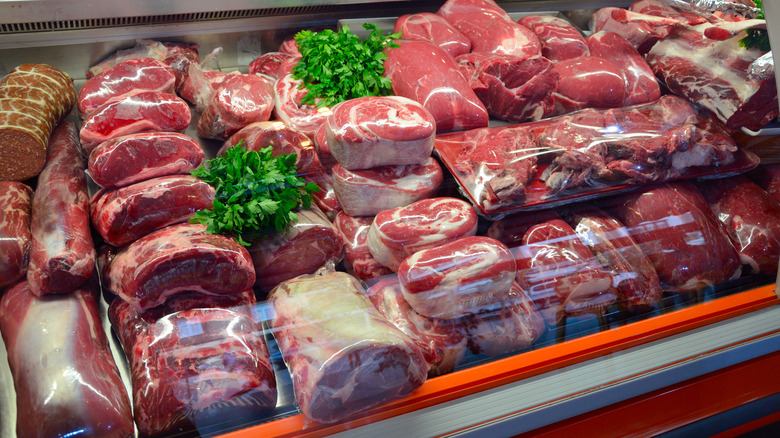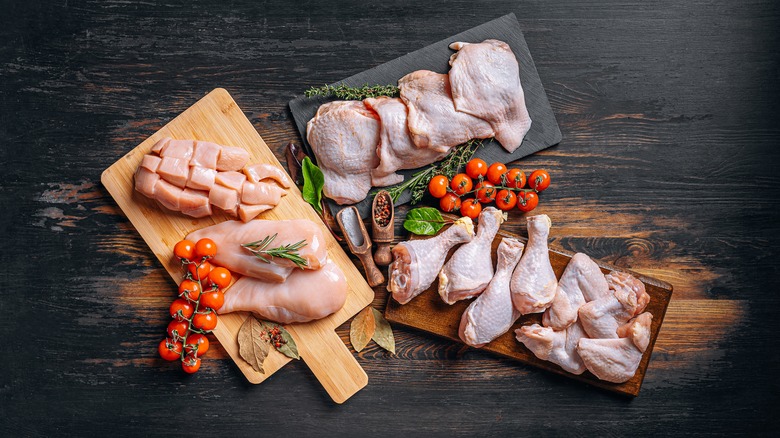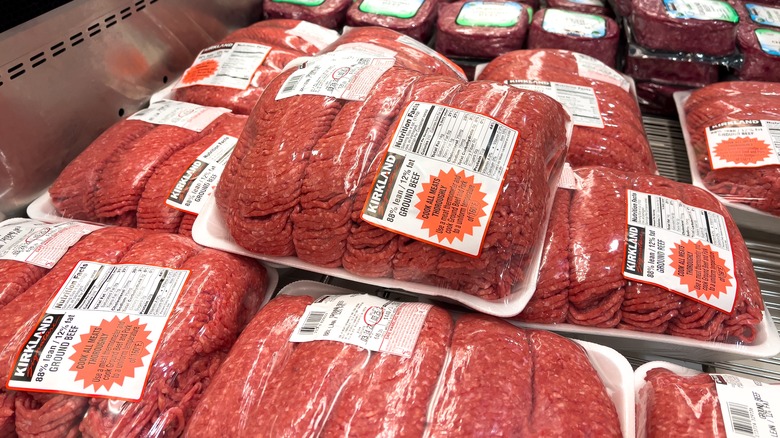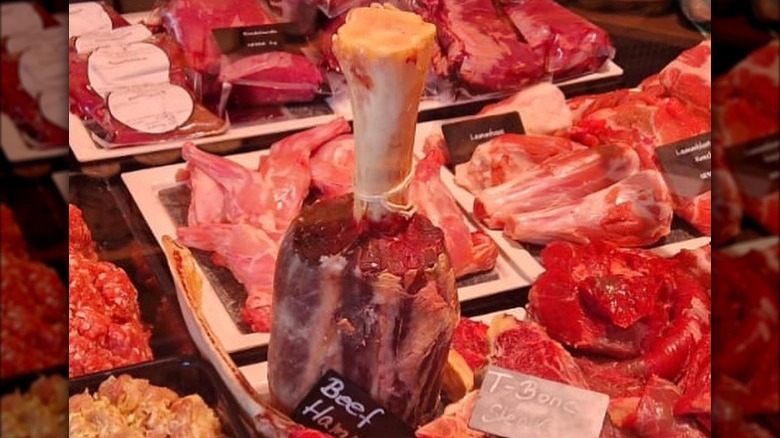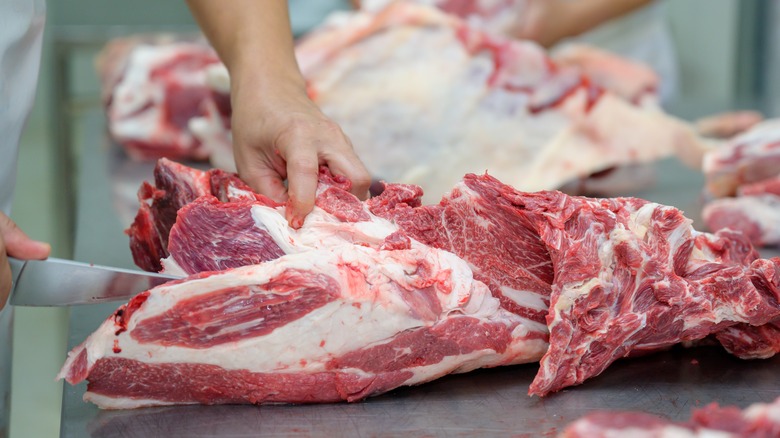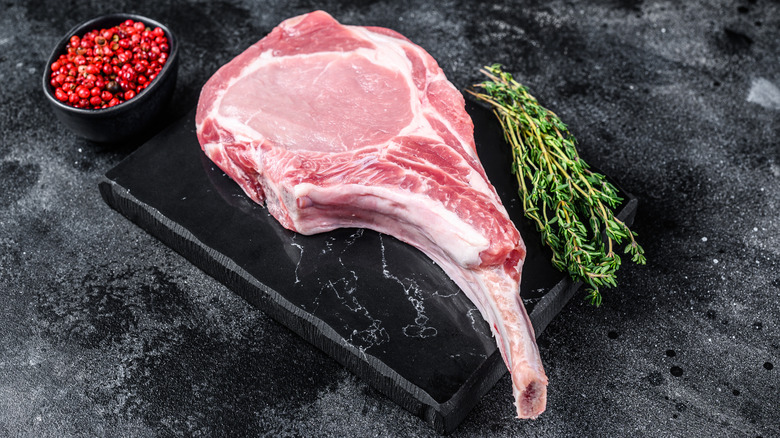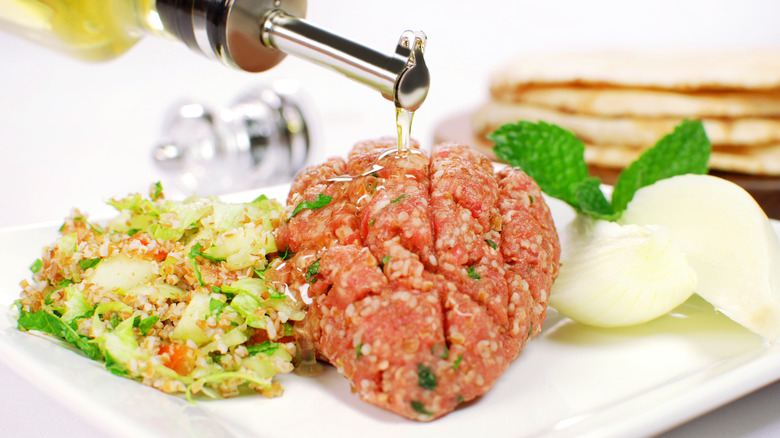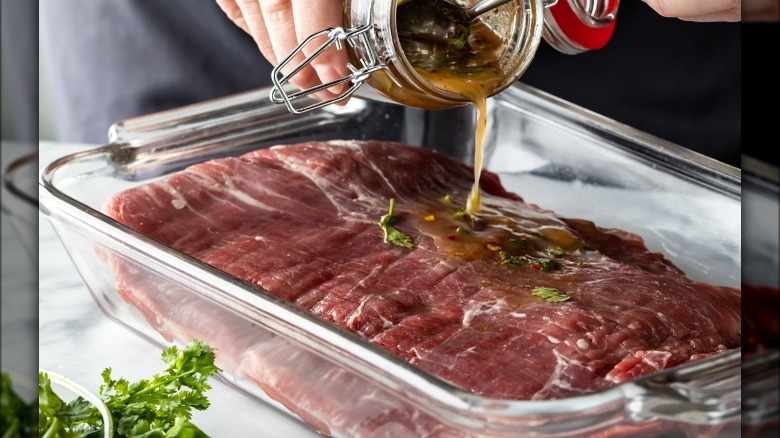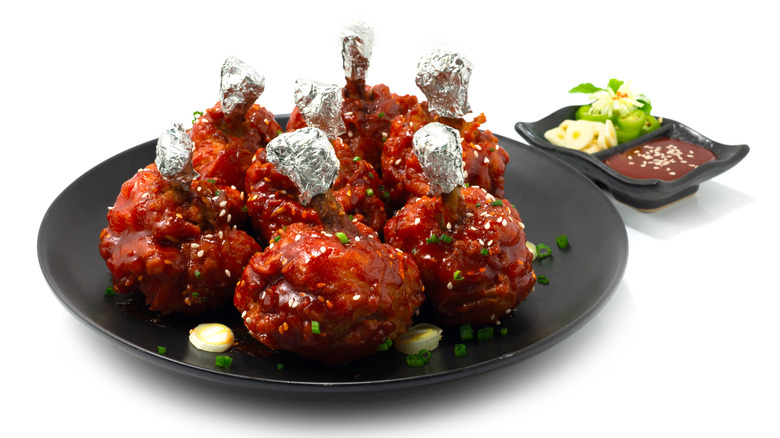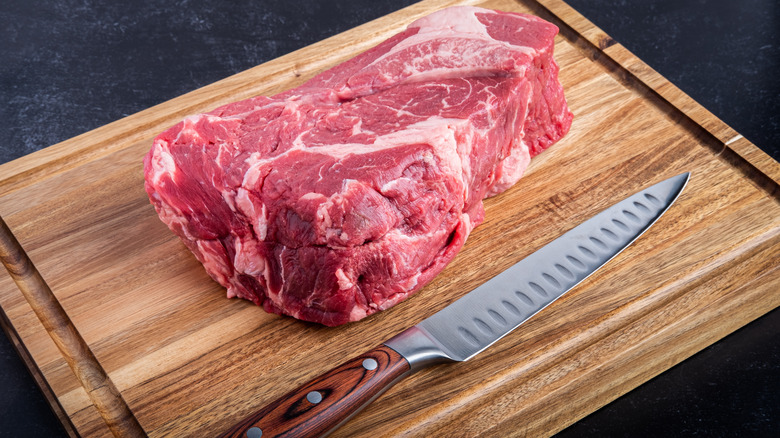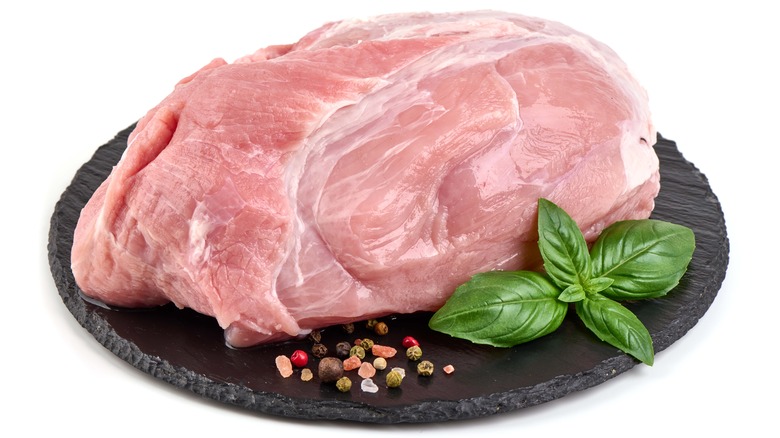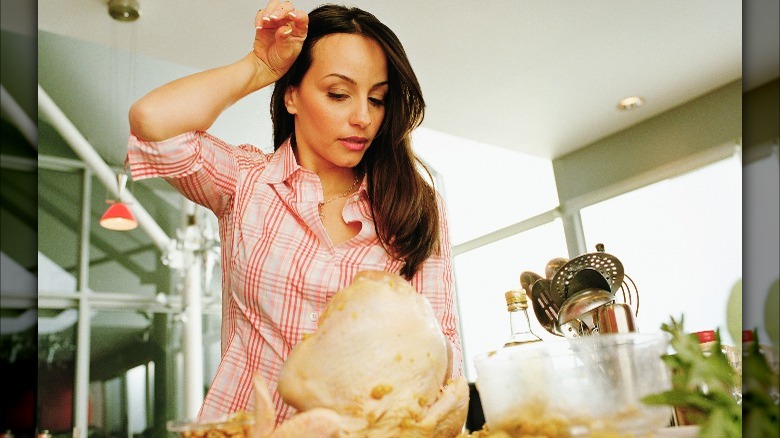11 Tips You Need When Buying Meat At The Grocery Store
Accomplished food author and butchering expert Matt Moore knows a thing or two about meat. He's covered everything from low-and-slow smoking techniques to hot-and-fast grilling, but in his most recent book, "Butcher on the Block," Moore makes connections between the local butcher, the meat they sell, and the people who enjoy eating it. "This is not a book about butchering, per se," he says. "I want people to get together and invite others over for dinner. The butcher is a great place to source ingredients for those dinners, and you can strike up a friendship with your butcher as well."
We had the chance to talk to Moore about his favorite tips for buying and preparing meat. He's especially big on getting your hands dirty and doing a bit of at-home butchering, like breaking down a whole chicken into its individual cuts. Moore emphasizes that while reading tips is a good thing to do, the best way to learn is by doing.
Buy your chicken whole
Butchering a whole chicken is one of those culinary skills that any cook worth their salt should be able to do. But Moore says he noticed a lot of people haven't been doing that: "During COVID, if you went through the supermarket, you'd find that all the pre-butchered items were all gobbled up, but the whole chickens were always just sitting there."
Breaking down a whole chicken isn't just a culinary flex, it's also a great way to save money. Before getting started, make sure your knife has been properly sharpened. Also, put the chicken dry to minimize the spread of raw chicken juice. With the breast side up, start by cutting away the skin at both of the chicken's hip joints. Flip the bird over, grab each leg, and pull back to dislocate them. Use your knife to sever each leg quarter. Pull each wing back and use your knife to cut through the tendons connecting them to the body. Remove the wishbone by cutting an outline around it and pulling it away with your hands. Then, cut each breast away from the chicken's rib cage, pulling as you cut. Finally, cut the leg joints to separate the thighs from the drumstick. You should have two of each: breasts, wings, drumsticks, and thighs.
Ground beef should be your go-to option
Classic butchering techniques are all well and good when it comes to entertaining, but what about buying meat for a hectic weeknight or an impromptu barbecue? According to Moore, your go-to should be the "rockstar" of the butcher counter: ground beef. "It's easily utilized and you can store it in the freezer," he explains.
When buying ground beef, it's important to think a lot about the fat content. If you're making hamburgers, you're going to want ground beef that's 80% or 85% lean and 20% or 15% fat. Because burgers are cooked relatively quickly, they retain a lot of the fat in ground beef, which makes for great flavor. If you're watching your weight or plan on cooking down ground beef significantly, you might want to opt for 90% or 90% lean.
It's also a good idea to buy ground beef in bulk. Large packages of beef are priced at a lower cost per pound than smaller packages, and as Moore mentioned, ground beef takes well to the freezer. If you pre-portion your meat before popping it into the freezer, it makes your preparation much easier than freezing one massive block of meat.
Swing the Beef Hammer
"I'm not the biggest guy on social media," Moore says, "but the beef hammer just kind of chased me on there." Wait, what? The beef hammer? This unique cut of beef shank recently went viral on social media thanks to its eye-catching, truncheon-like shape. It's a fairly lean cut, without much intramuscular fat or connective tissue, which makes it ideal for smoking or braising. Cooking this cut of beef low and slow brings out its rich flavor and produces fall-off-the-bone tenderness. Because it's lean, the beef hammer is ideal for people who want meat for its protein, not its fat. If you're more concerned with flavor than your diet, you may want to cook this cut with butter or another kind of fat.
Before purchasing, you should make sure it's properly trimmed. If you are going to smoke the beef hammer, cook it with the bone facing up to prevent delicious liquid bone marrow from spilling out into your smoker. Wrapping this cut in elastic bands or butcher's twine is also a good idea before cooking it low and slow. This helps keep the meat together as it cooks.
Ask the butcher to trim fat and remove silver skin
There's an aesthetic quality to properly trimmed meat, but removing excess fat and silver skin also leads to higher-quality cooking. Unfortunately, many people don't appreciate the importance of properly trimming meat before cooking it. "Everybody wants to make a whole beef tenderloin during the holidays," Moore says, "and I've been to a lot of houses where people haven't trimmed the tenderloin and removed all the silver skin."
Though it can be tricky to deal with, removing silver skin is something you should do, and Moore offers a few key tips in his book. Anatomically speaking, silver skin is similar to collagen. But while the latter breaks down when it's cooked, the former becomes tough and chewy. Silver skin also prevents any rubs or marinades from penetrating into the meat.
While removing silver skin may seem like a daunting task, it can be a quick process for someone who knows how to do it: Simply slide the knife underneath the silver skin, make a cut to create a large flap, and flip the knife around to cut off the flap you've created. You can also ask your butcher to trim off excess fat but remember that fat equals flavor so you may want your butcher to leave a little bit behind.
Buy pork chops to french at home
If you've ever seen Bugs Bunny or Tom and Jerry wreaking havoc at a fancy mid-century dinner party, you probably noticed that the ends of bones on a turkey or roast were covered with frilly paper caps. Although we don't use those adornments anymore, it is common for professional chefs to cut away access meat at the end of a bone, which is a technique known as frenching. If you're going to spend money on a nice thick bone-in pork chop, Moore recommends taking an extra step for a better presentation. "If I go to a steakhouse and I see a pork chop on the menu, that's what I'll order over steak," he says. "I love the idea of taking that loin cut and frenching the chop."
Some home cooks might bristle at the thought of taking an extra step for the sake of presentation. However, frenching a bone only takes a few seconds and it just looks freakin' cool. Start by making a cut between the main loin muscle and the rib meat on the thin end of the chop. Then, cut along all sides of the bone to remove the rib meat. Finally, use the heel of your knife to scrape off any remaining meat and connective tissue to produce a clean bone. It's also a good idea to trim excess fat from your pork chops, especially when grilling.
For raw meat dishes, ask the butcher about their handling practices
One of the more unique parts of "Butcher on the Block" is the section on kibbeh nayah, which is a raw meat dish that's part of Moore's Lebanese heritage. "It's kind of like our gumbo: It's what we love and what we argue over because everybody makes it a little bit differently," he says.
When discussing the prospect of making a raw meat dish, Moore stresses the importance of sanitation and handling best practices. "When my grandfather made kibbeh nayah, he would grind meat first thing in the morning, three times on clean blades, and we would make the dish. When I was working at a local butcher, they would sterilize everything in the evenings, and ground beef is the first thing we would do."
Many people are intimidated by the idea of making a raw meat dish like kibbeh nayah or steak tartare, but you shouldn't be. When getting meat that won't be cooked, be sure to ask your butcher about their handling practices and recommendations for a raw meat dish. It's also important to get the right cut, and some of the best cuts of meat for steak tartare and other raw dishes include beef tenderloin and top sirloin.
Marinade cheaper cuts to save money
If you're looking to save some money at the meat counter, consider buying a cheaper cut and using a marinade to produce a tender, flavorful dish. "You can get a lot of flavor and tenderness at a quarter of the price of the more premier-style cuts," Moore says. "Sometimes, people come over for a dinner I've made and say, 'Gosh, what is that, filet? Is it ribeye?' I just laugh and say, no it's just properly marinated and cooked top sirloin!"
Marinating meat is a pretty simple culinary technique, but there are some basic guidelines you should follow. First, you don't need to marinate meat for over 24 hours. A good marinade can do a lot in just 20 minutes. While an overnight marinade is fine, several days in the liquid can make the meat tough and stringy. Also, because a marinade only penetrates a few millimeters, it's best to use thinner cuts of meat.
Elevate wings or legs by making lollipops
If you like making chicken wings or legs, but you're sick of the same old preparation, Moore recommends making these cuts into "lollipops" to switch things up and create an eye-catching presentation. Chicken wing lollipops are less messy to eat than standard wings or legs, and they are really popular in the barbecue circuit these days, Moore adds.
Chicken lollipops are made by frenching, which involves scraping meat away from the bone. This technique is fairly easy when done with chicken legs or drumettes. Simply use your knife to cut and scrape away as much meat as possible from the thin ends of these cuts. If you want, you can also cut the tip off the thick ends of these cuts to make a flat surface and stand your lollipops on end as they cook.
Making lollipops from the flat chicken wingettes is a bit more involved and it requires a sharp knife. First, use your knife to separate the thicker bone from the thinner bone by cutting the joint that holds them together. Next, cut and scrape away meat from the thinner bone. Then, use your hand to pull out the thinner bone. Cut and scrape away meat from one end of the remaining bone. Finally, push the meat to one end of the bone to form the lollipop.
Save money by buying roasts
There's never a bad time to save a few bucks and Moore says an easy way to do that is to buy large roasts. These have a big upfront cost because they have a lot of meat on them, but on a per-pound basis, these cuts offer great bang for the buck. In particular, Moore says a dish like Mississippi roast is a great way to make a lot of food that can last for several meals. Simply buy a chuck roast or rump roast, season it, and toss it in a slow cooker with ranch dressing mix, dry onion soup mix, unsalted butter, and pepperoncini peppers. "The barbecue mantra of low and slow cooking allows time and temperature to create an unbelievable result," Moore says.
Another way to save money is to buy a large roast and butcher it into smaller cuts, for which you'd normally pay a premium price. For example, a top blade roast is actually two flatiron steaks connected by a thick membrane. All you need to do is use a sharp knife to cut the steaks away from the membrane. You can also get boneless short ribs, chuck steak, and stew meat from a chuck roast. Simply cut along the large membranes that act as natural seams in the roast. The long side of the roast with the most marbling is your boneless short rib cut, while the end of the roast with the eye is your chuck steak. The trimmings around these cuts can be saved for stew meat.
Pork butt is more versatile than you can imagine
While traveling in Greece to research his book, Moore came upon gyros made with pork, which is different than the beef and lamb combination typically found stateside. "I think that Greek-style preparation is a unique one that you don't often see," says Moore, who included a recipe for the dish in "Butcher on the Block".
Before you make your purchase, it's important to know the difference between pork butt and pork shoulder. While both of these cuts come from a pig's shoulder, the fatty pork butt comes from the upper part of the shoulder, while the leaner shoulder cut comes from the upper part of the front leg. Also called picnic shoulder, pork shoulder can be easily identified in the butcher case because it's usually sold bone-in with the skin on.
If you don't want to bother experimenting with unconventional recipes, you can do a lot with the trusty standby of pulled pork. After you are done making sandwiches, leftover pulled pork can be used to make chili, loaded nachos, tacos, lettuce wraps, and pizza.
Embrace the learning curve
If you find the butcher counter to be an intimidating place, you're not alone! Take comfort in the fact that some of the most skillful and respected butchers learned through experience. If you are going to get better buying, preparing, and cooking meat, you should embrace the learning curve and be willing to make mistakes, according to Moore. "Any butcher you go to, they didn't get their wisdom by reading a book," he says. "They gained it through experience."
Moore calls his new book "a primer" and suggests that reading it should inspire you to try new things, and occasionally fail. Moore also suggests learning from those who came before you. The butcher at your local grocery store might be working for a large corporation, but that doesn't mean they aren't knowledgeable about their products and how to use them. "Butchers are the most underpaid chefs in the world, and they're giving up all their secrets for free!" Moore says.
That being said, there are a few basic knife skills and techniques you should know. One of the most important is to have a dedicated cutting board for raw meat, ideally made of plastic or some other nonporous material. When you cut raw meat, juices can seep into a wooden cutting board and cultivate dangerous bacteria. It's okay to cook a bad dish, but you don't want to get people sick.
